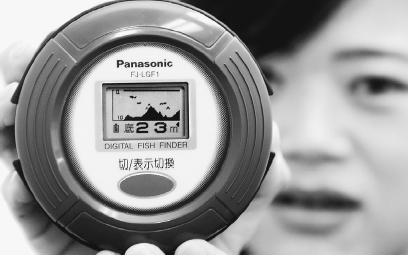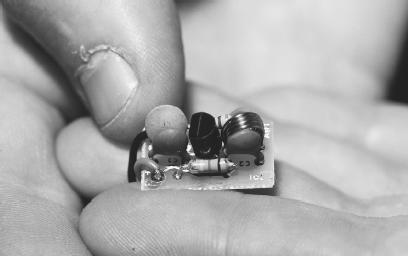Ultrasonics - How it works
Sound Waves
Then there are waves of pulses, such as light, sound, radio, or electromagnetic waves. Sound travels by means of periodic waves, a period being the amount of time it takes a complete wave, from trough to crest and back again, to pass through a given point. These periodic waves are typified by a sinusoidal pattern. To picture a sinusoidal wave, one need only imagine an x-axis crossed at regular intervals by a curve that rises above the line to point y before moving downward, below the axis, to point y. This may be expressed also as a graph of sin x versus x. In any case, the wave varies by equal distances upward and downward as it moves along the x-axis in a regular, unvarying pattern.
Periodic waves have three notable interrelated characteristics. One of these is speed, typically calculated in seconds. Another is wavelength, or the distance between a crest and the adjacent crest, or a trough and the adjacent trough, along a plane parallel to that of the wave itself. Finally, there is frequency, the number of waves passing through a given point during the interval of one second.
Frequency is measured in terms of cycles per second, or Hertz (Hz), named in honor of the nineteenth-century German physicist Heinrich Hertz. If a wave has a frequency of 100 Hz, this means that 100 waves are passing through a given point during the interval of one second. Higher frequencies are expressed in terms of kilohertz

Clearly, frequency is a function of the wave's speed or velocity, and the same relationship—though it is not so obvious intuitively—exists between wavelength and speed. Over the interval of one second, a given number of waves pass a certain point (frequency), and each wave occupies a certain distance (wavelength). Multiplied by one another, these two properties equal the velocity of the wave.
An additional characteristic of waves (though one that is not related mathematically to the three named above) is amplitude, or maximum displacement, which can be described as the distance from the x-axis to either the crest or the trough. Amplitude is related to the intensity or the amount of energy in the wave.
These four qualities are easiest to imagine on a transverse wave, described earlier with reference to the x-axis—a wave, in other words, in which vibration or harmonic motion occurs perpendicular to the direction in which the wave is moving.
Such a wave is much easier to picture, for the purposes of illustrating concepts such as frequency, than a longitudinal wave; but in fact, sound waves are longitudinal. A longitudinal wave is one in which the individual segments vibrate in the same direction as the wave itself. The shock waves of an explosion, or the concentric waves of a radio transmission as it goes out from the station to all points within receiving distance, are examples of longitudinal waves. In this type of wave pattern, the crests and troughs are not side by side in a line; they radiate outward. Wavelength is the distance between each concentric circle or semicircle (that is, wave), and amplitude the "width" of each wave, which one may imagine by likening it to the relative width of colors on a rainbow.
Having identified its shape, it is reasonable to ask what, exactly, a sound wave is. Simply put, sound waves are changes in pressure, or an alternation between condensation and rarefaction. Imagine a set of longitudinal waves—represented as concentric circles—radiating from a sound source. The waves themselves are relatively higher in pressure, or denser, than the "spaces" between them, though this is just an illustration for the purposes of clarity: in fact the "spaces" are waves of lower pressure that alternate with higher-pressure waves.
Vibration is integral to the generation of sound. When the diaphragm of a loudspeaker

The Speed of Sound: Consider the Medium
The speed of sound varies with the hardness of the medium through which it passes: contrary to what you might imagine, it travels faster through liquids than through gasses such as air, and faster through solids than through liquids. By definition, molecules are closer together in harder material, and thus more quickly responsive to signals from neighboring particles. In granite, for instance, sound travels at 19,680 ft per second (6,000 mps), whereas in air, the speed of sound is only 1,086 ft per second (331 mps). It follows that sound travels faster in water—5,023 ft per second (1,531 mps), to be exact—than in air. It should be clear, then, that there is a correlation between density and the ease with which a sound travels. Thus, sound cannot travel in a vacuum, giving credence to the famous tagline from the 1979 science fiction thriller Alien: "In space, no one can hear you scream."
When sound travels through a medium such as air, however, two factors govern its audibility: intensity or volume (related to amplitude and measured in decibels, or dB) and frequency. There is no direct correlation between intensity and frequency, though for a person to hear a very low-frequency sound, it must be above a certain decibel level. (At all frequencies, however, the threshold of discomfort is around 120 decibels.)
In any case, when discussing ultrasonics, frequency and not intensity is of principal concern. The range of audibility for the human ear is from 20 Hz to 20,000 Hz, with frequencies below that range dubbed infrasound and those above it referred to as ultrasound. (There is a third category, hypersound, which refers to frequencies above 10 13 , or 10 trillion Hz. It is almost impossible

What Makes the Glass Shatter
The lowest note of the eighty-eight keys on a piano is 27 Hz and the highest 4,186 Hz. This places the middle and upper register of the piano well within the optimal range for audibility, which is between 3,000 and 4,000 Hz. Clearly, the higher the note, the higher the frequency—but it is not high frequency, per se, that causes a glass to shatter when a singer or a violinist hits a certain note. All objects, or at least all rigid ones, possess their own natural frequency of vibration or oscillation. This frequency depends on a number of factors, including material composition and shape, and its characteristics are much more complex than those of sound frequency described above. In any case, a musician cannot cause a glass to shatter simply by hitting a very high note; rather, the note must be on the exact frequency at which the glass itself oscillates. Under such conditions, all the energy from the voice or musical instrument is transferred to the glass, a sudden burst that overloads the object and causes it to shatter.
To create ultrasonic waves, technicians use a transducer, a device that converts energy into ultrasonic sound waves. The most basic type of transducer is mechanical, involving oscillators or vibrating blades powered either by gas or the pressure of gas or liquids—that is, pneumatic or hydrodynamic pressure, respectively. The vibrations from these mechanical devices are on a relatively low ultrasonic frequency, and most commonly they are applied in industry for purposes such as drying or cleaning.
An electromechanical transducer, which has a much wider range of applications, converts electrical energy, in the form of current, to mechanical energy—that is, sound waves. This it does either by a magnetostrictive or a piezoelectric device. The term "magnetostrictive" comes from magneto, or magnetic, and strictio, or "drawing together." This type of transducer involves the magnetization of iron or nickel, which causes a change in dimension by forcing the atoms together. This change in dimension in turn produces a high-frequency vibration. Again, the frequency is relatively low in ultrasonic terms, and likewise the application is primarily industrial, for purposes such as cleaning and machining.
Most widely used is a transducer equipped with a specially cut piezoelectric quartz crystal. Piezoelectricity involves the application of mechanical pressure to a nonconducting crystal, which results in polarization of electrical charges, with all positive charges at one end of the crystal and all negative charges at the other end. By successively compressing and stretching the crystal at an appropriate frequency, an alternating electrical current is generated that can be converted into mechanical energy—specifically, ultrasonic waves.
Scientists use different shapes and materials (including quartz and varieties of ceramic) in fashioning piezoelectric crystals: for instance, a concave shape is best for an ultrasonic wave that will be focused on a very tight point. Piezoelectric transducers have a variety of applications in ultrasonic technology, and are capable of acting as receivers for ultrasonic vibrations.